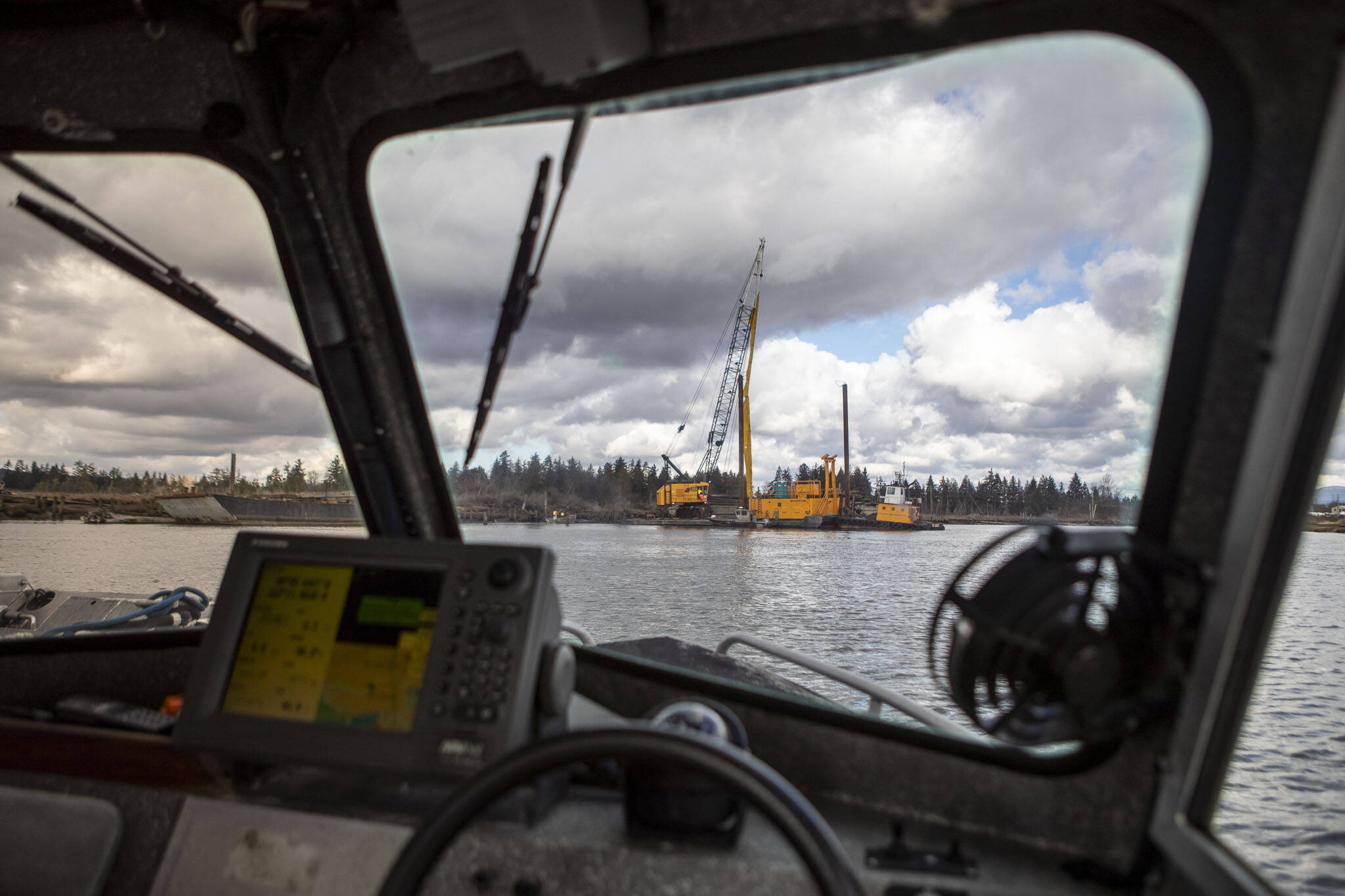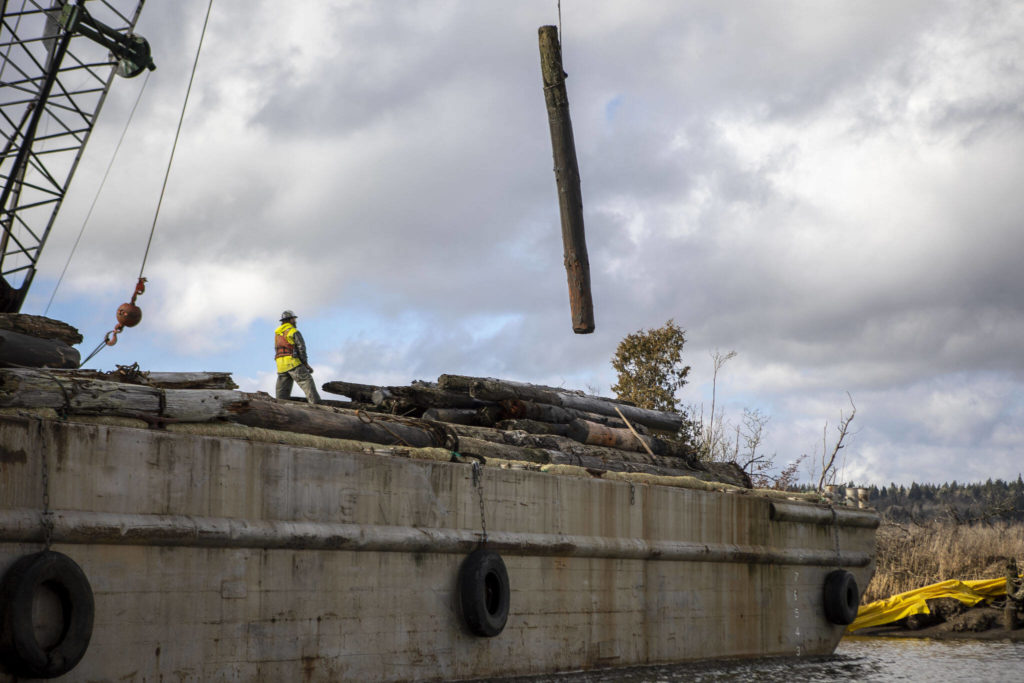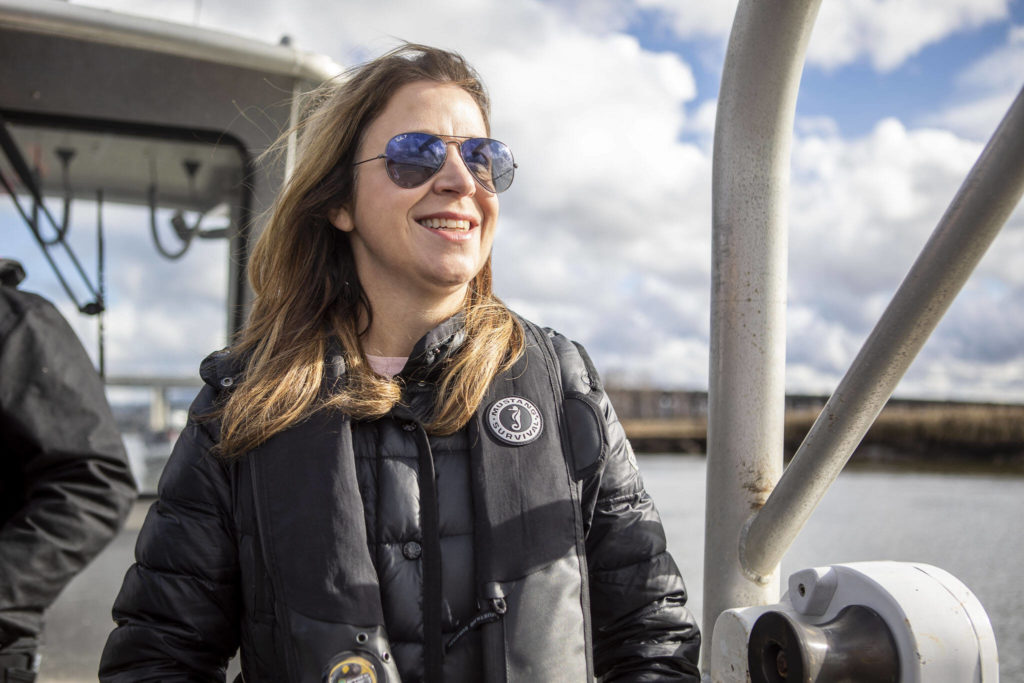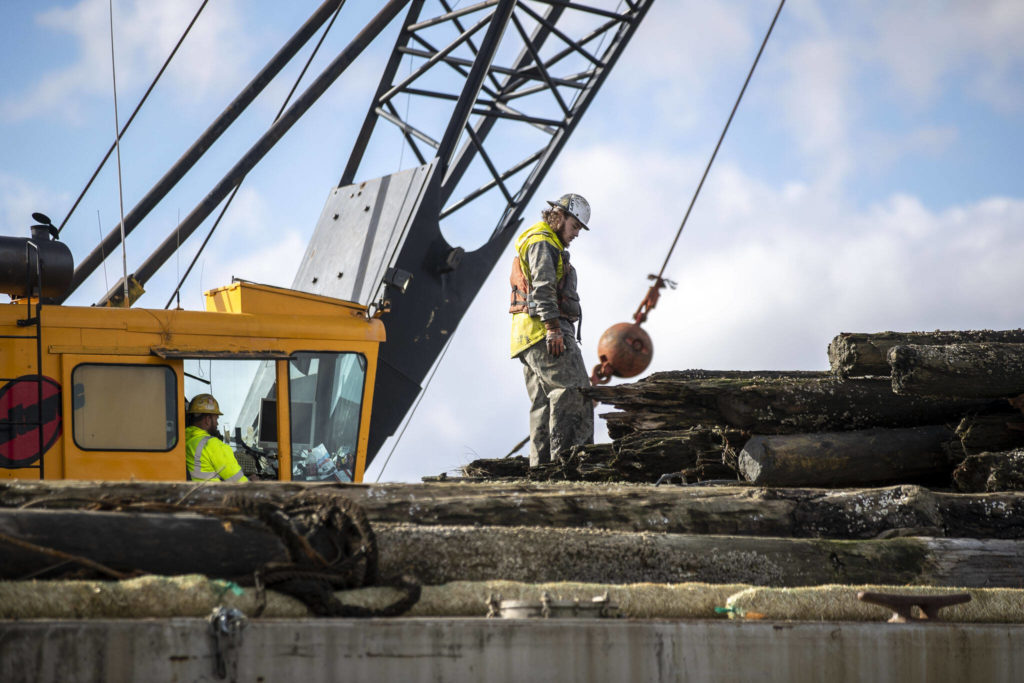MARYSVILLE — A sound like a jackhammer echoed up and down the shallow reaches of Steamboat Slough. Folks taking their dogs for an early afternoon stroll in nearby Ebey Waterfront Park on a sunny Friday probably hardly registered the racket, but from across the stream, it was deafening.
The rig responsible for the noise was big enough to match. A crane towered 100 feet above the water, perched on top of a gargantuan boat. Its operator carefully lowered a vibratory hammer onto one of the dozen or so pilings sunk into the mud along the shoreline, the wood so aged it seemed the huge chunk of metal should simply snap it on contact.
But as the hammer started its noisy work once more, the ancient piling gradually gave up its stake in the riverbed, shaking loose the decades worth of silt. A minute or so later, it all came free at once, revealing an extra 10 feet of wood previously sunk deep into the muck. The crane placed it on a stack of pilings destined for a specialized landfill, piled on the barge like so many Lincoln Logs.
The piling was one of nearly 300 removed from Steamboat and Ebey sloughs, two arms of the Snohomish River that drain into Puget Sound just west of Marysville, over the past couple of weeks, said Christopher Robertson, aquatic restoration manager for the state Department of Natural Resources. By removing the creosote-soaked pilings from the waterways, the department is subtracting a key source of toxic pollution from crucial salmon habitat, Robertson said.
From her vantage point on a small motorboat a safe distance from the barge, state Commissioner of Public Lands Hilary Franz was already brainstorming next steps as the crane freed another piling. This stretch of water will soon be cleared of the toxic relics, but finishing this project is just one small step in a “watershed-wide” approach to restoring salmon habitat.
These particular pilings, according to Robertson, were once used as moorings for logs floating down the river during Marysville’s mill town heyday. Creosote, a thick black coal tar derivative, was used to waterproof the wooden pilings. Some recovered wood absorbs more than a gallon of liquid creosote per foot, Robertson said. The logs often emerge dripping with creosote, wet as the day they were planted 80 years ago or more, thanks to the airtight environment of the riverbed.
Having those toxins constantly leaching into the river is an obvious problem for the aquatic life exposed to them, especially the salmon that absorb the chemicals and the orcas that eat those salmon, Robertson said. Not all the pilings are treated, though, so crews will leave some clean ones behind. Removing them all could subtly disrupt the river’s flow, disturbing habitat, and besides, they’ll create more habitat as they decay.
The department has removed about 15,000 pilings since the early 2000s, Franz said, amounting to 21,000 tons of creosote that’s no longer seeping into waterways. Finishing off the last of them was an early priority in DNR’s Watershed Resilience Action Plan, announced by Franz’s office last year, because it was a relatively simple way to quickly address a key source of water pollution in the Snohomish watershed. Derelict vessels, like the 100-foot Midas pulled from the Snohomish River in 2019, are a target for the same reasons.
Uprooting junk from the river is by no means easy or cheap — piling removal alone cost about $280,000, according to DNR spokesperson Joe Smillie — but it’s just one of many steps in Franz’s grand plan. WRAP takes a “tree to sea” approach to restoring salmon habitat, Franz said, starting from inland forests out to the ocean.
The WRAP Dashboard on DNR’s website lays out 34 specific outcomes the agency wants to achieve as part of its Snohomish watershed project, from establishing protections for disappearing kelp and eelgrass to a 3.5% increase in tree canopy cover among watershed cities. Franz said DNR will partner with county agencies and the Tulalip Tribes to work on these goals, just as they did in completing the piling removal project.
Many intricacies of these projects rely on the cooperation of private landowners, which isn’t always easy to obtain, Franz said. The problem of illegal marinas along Snohomish waterways, for example, will require DNR to work with those who built them. But by their very nature, it’s pretty difficult to get a hold of those folks, Franz said.
In other cases, it can be a matter of negotiation. Franz said one upcoming step, now that piling removal is nearly complete, is conducting an inventory of waterways on small forest landholdings. Once owners are tracked down, it can still take some time to work out a plan that achieves both the agency’s goals and the owner’s. But Franz is still confident the agency can swing its lofty goals by its stated target date of 2040.
“It’s about consistency, about bringing everyone — from the county to small private entities to anyone who helps plant trees in their urban forest — along on the plan,” Franz said. “We’re depending on all these small points to come together and tell the story of our watershed’s health from every angle.”
Riley Haun: 425-339-3192; riley.haun@heraldnet.com; Twitter: @RHaunID.
Talk to us
> Give us your news tips.
> Send us a letter to the editor.
> More Herald contact information.





























